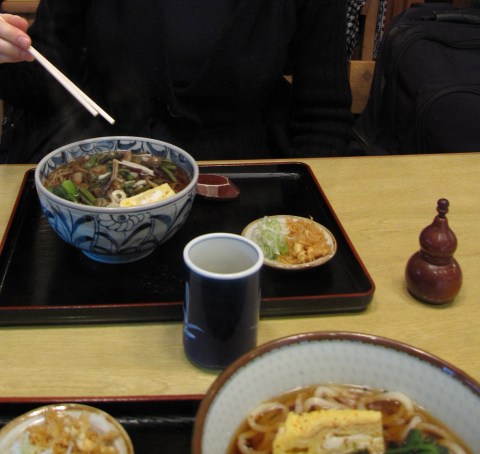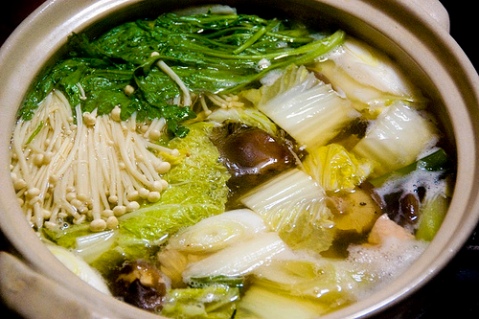The last vestiges of winter are slowly creeping away (at least they better be), so I thought I should write up these lovely stews while they still seem seasonally appropriate.
Our December trip to Japan gave us the opportunity to have several special dishes that are especially associated with wintertime.

Noodles: soba and udon
In mountain town of Gora, we had a fabulous lunch in a noodle restaurant. I chose soba—thin buckwheat noodles—and Yusuke selected udon, which is thick, almost doughy noodles. Both dishes had a light broth, probably soy sauce-based. My soba featured delicious mountain vegetables, like mushrooms (yay!), bamboo shoots, fiddleheads, and onions.

Daikon soup
My mother-in-law made this soup one evening during our visit. Root vegetables are especially popular during the winter, and so daikon is the main element, along with pork, shitake mushrooms, and mizuna, a flavourful leafy green. Daikon is a root veggie, but since it’s a radish, it’s not starchy like potato or squash. The texture is much smoother and juicer, especially when it’s nicely ripe. If it’s not good quality (like we sometimes get in Montreal), it’s rather stringy. In Japan, all of the daikon was huge, white, and smooth, and it melts in your mouth when cooked in a stew. In Montreal, in contrast, sometimes it’s small and skinny, greenish, and pock-marked. Boo. I miss daikon in Japan.

Oden
Oden is awesome. It’s a pot dish that typically has various soy-based and processed fish-based products that are completely foreign to Western cuisine. The wikipedia article has a more detailed explanation. My mother-in-law made quite the oden feast. One of my sisters-in-law and I monopolized the konnyaku, but I liked all of the new things I tried in this dish. Another of my favourites was the kombu, which is thick seaweed, neatly tied into bows here. There’s also hanpen (the white triangles of surimi aka fish purée), gobomaki (boiled greater burdock root wrapped in surimi), chikuwa (tubes of surimi), ganmodoki (fried balls of tofu mixed with grated vegetables), and atsuage (deep fried tofu).

Nabe
Finally, we had nabe on two different occasions (at a friend’s house and at a fabulous restaurant in Tokyo’s Ginza district). Nabe (short for nabemono) is central to Japanese culture and cuisine. It is essentially a hot pot dish, cooked on the dining table, in which all different types of meat, seafood, and veggies are boiled in a special broth. Everyone is served out of the communal pot on the table, so it brings a warmth and closeness when shared among family and friends. Chankonabe is special, extra-hearty nabe that is a staple in sumo wrestlers’ training diets…which is what we had in Ginza: a million different types of mushrooms (yay!), along with some kind of meat, napa, onions, eggs, tofu, noodles, and some other stuff that I can’t remember. At the lovely home of a friend, we had nabe chock full of succulent oysters (sooo fabulously juicy and briny), white fish, mushrooms, carrots, napa, and and other veggies. We didn’t take any pictures of our nabe, so I borrowed the one above from “Tavallai” on Flickr: http://www.flickr.com/photos/tavallai/2084203089/. And another nabe pic with oysters is here: http://www.flickr.com/photos/upon/2314309029/

Soy milk nabe « Chez Yusuke said
[…] notes about nabe from a previous post (and see also this […]